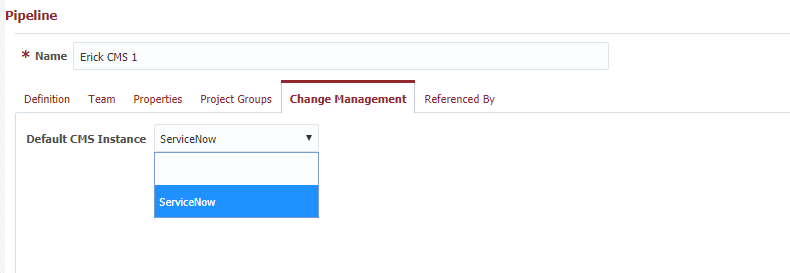| Table of Contents |
|---|
...
| Info | ||
|---|---|---|
| ||
@since 5.2.0.1 The pipeline can identify the default CMS istance to select for releases which use this pipeline. This allows setting a default, and eliminates the having to remember to select the instance on each release. |
Field | Description |
|---|---|
Name | The name of the pipeline. |
Updated On | The user who last updated the pipeline verson (read-only). |
Updated By | The last update date/time of the pipeline version (read-only). |
Definition
...
Field | Description | |||||||
|---|---|---|---|---|---|---|---|---|
Active | Indicates whether the pipeline property is active. Inactive properties will not appear on the release. | |||||||
| Code | A code for the property, as appropriate for variables within Groovy or Shell scripts. (e.g. no spaces or special characters other than underscore.) | |||||||
Description | A meaningful description for the property. | |||||||
| Data Type | The data type for this property. Valid types are Boolean, Double, Integer, String. | |||||||
| Subtype | Not currently used. | |||||||
| Default Value | A default value to assign to the property if not specified on the release. | |||||||
| Rows | Defines the height of the component to display when capturing the value from the user. | |||||||
| Columns | Defines the length of the component to display when capturing the value from the user. | |||||||
| Display Name | A meaningful name for the property used for display. | |||||||
| List Data | A list of valid values for the property. Optional, and only applicable for String data type. Allowed formats:
| |||||||
| Encrypted | Whether or not to encrypt the value, not display on screen or in the logs. Only applicable for String data type. | |||||||
| Multiselect | Whether multiple values can be selected from the List Data. Only applicable for String data type, and when List Data is provided. | |||||||
| Length | The maximum allowed length of the property value. Optional, and only applicable for String data type. | |||||||
| Required | Whether or not a value is required for this property. | |||||||
| Min Value | Minimum allowed value. Optional, and only applicable for Integer and Double data types. | |||||||
| Max Value | Maximum allowed value. Optional, and only applicable for Integer and Double data types. | |||||||
| Validator1 | Optional Groovy Script to validate provided value. The script should return true if the value is valid, and false otherwise. The user specified value is available to the script in the Value variable. If not valid, the ValidationMessage is displayed to the user. For example,
| |||||||
| Validator2 | Optional Groovy Script to validate provided value. See Validator1. | |||||||
| Validator3 | Optional Groovy Script to validate provided value. See Validator1. | |||||||
| Validator4 | Optional Groovy Script to validate provided value. See Validator1. | |||||||
| Validator5 | Optional Groovy Script to validate provided value. See Validator1. |
Click the button to save the changes to the property (be sure to also save the pipeline, or changes will be lost), or to revert any unsaved changes.
Snapshot Variables
Snapshot variables provide state for the life of a snapshot. Such state afford the ability to store some data as part of a step or gate in one stage, and consume it or make decisions in a later stage. One classic example is to store off a CMS ticket which was entered or created in one stage, and feed it into another stage which will use the same ticket. The pipeline defines the metadata for any snapshot variables which are available, and values can be set or retrieved using Custom Gates or Custom Steps.
To create a Snapshot Variable, click on the icon. Enter the required information and click Save.
| Field | Description |
|---|---|
| Code | The identifier which is used to access the variable from Groovy |
| Active | Whether the variable is active or not. Defaults to true. |
| Description | A description for the variable. |
| Data Type | The data type of the variable. Allowed types are Boolean, Integer, Double, or String. |
| Display Name | The display name for the variable. |
Project Groups
Project Groups provide categorization tags for release content. As such, pipelines define the tags, and deploy segments of the content based on those tags. Releases consuming the pipeline can then tag its content as belonging to those groups.
...
To delete a project group, click on the icon for the project group you wish to remove.
Change Management
@since 5.2.0.1
The default CMS Instance will be configured automatically on the release which uses this pipeline. The default CMS is set on the release only if the release has not explicitly set the CMS instance. This allows the pipeline developer to indicate that all releases should utilize the selected instance, but it still may be overridden on the release in rare cases where that makes sense. If all releases for this pipeline should use a particular CMS instance, the default eliminates having to remember to select it on each and every release.
Referenced By
...







